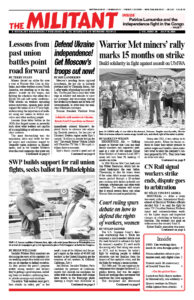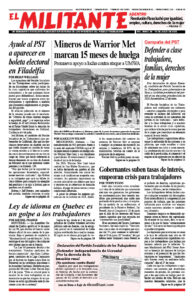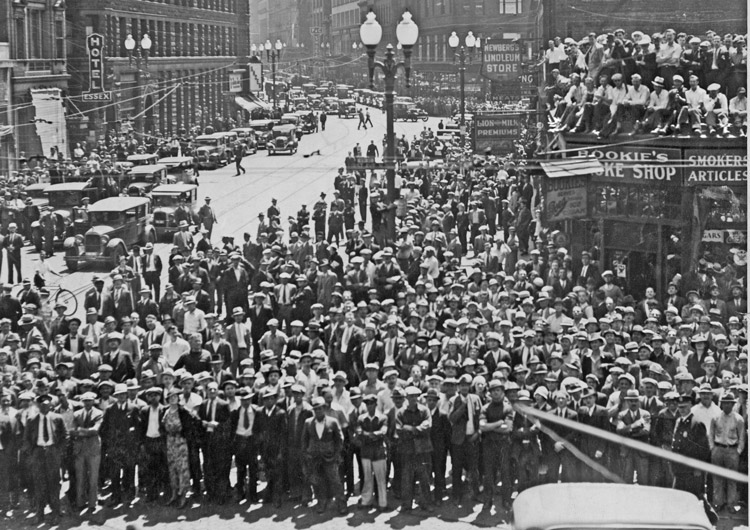Miners forced on strike for over a year at Warrior Met Coal in Alabama, and other workers across North America, are standing up to the employers’ assault on our wages, and fighting for schedules that allow for a family life and safe work conditions. With attacks on workers mounting across industries, opinion polls show support for unions is at a 57-year high, underscoring the importance of workers using our unions to defend ourselves and other working people.
Lessons from labor battles in the 1930s that forged unions as powerful tools show what workers are capable of accomplishing to advance our own class interests.
The most far-reaching was the organizing drive and battle for better wages and conditions waged by Teamster union militants in Minneapolis, and in the broader Midwest over-the-road campaign that grew out of it. They united drivers and other workers, organized the unemployed, owner-operators, farmers and women into an effective fighting force. These battles, described in Farrell Dobbs’ four-volume Teamster books, are available from distributors.
Teamster union and Socialist Workers Party leaders, like Farrell Dobbs, fought against moves by the Franklin Delano Roosevelt administration and Washington’s political police — the FBI — to frame up unionists organizing opposition to Washington’s drive to get into the second imperialist world war.
They set an example of uncompromising working-class struggle that was emulated in the sit-down strikes that marked the rise of the United Auto Workers and Congress of Industrial Organizations in the mid-1930s. Dauntless and disciplined, workers battled not only the bosses, but the government, cops, court injunctions and the National Guard. Millions were drawn to the unions, as workers began to sense their own class power, including, for the first time, growing numbers of Black workers.
In the decades since, most union officials have settled into cozy relations with the bosses and government regulators, focusing on dues-collecting operations, not advancing the class struggle. Instead of helping workers mobilize to fight and win allies to their side, they’ve increasingly subordinated workers’ interests to getting so-called friends of labor in the Democratic Party elected. As labor’s ranks are forced to find ways to protect ourselves, how we use our unions to fight effectively for what we need is sharply posed.
All signs point to a global slowdown in production and trade, following decades in which capitalist profit rates have tended to decline. A survey issued July 1 of employers worldwide says that factory production is dropping, and new orders are falling at their fastest rate since May 2020. Copper prices, used as a gauge of economic growth because a variety of goods contain this metal, have dropped to their lowest level in 18 months.
Fear of a recession roiling wealthy capitalist investors was reflected in a sharp plunge in stock prices on the S&P 500 in the first half of 2022, the steepest drop since 1970.
The slowdown in the capitalist economy comes on top of skyrocketing inflation. Workers confront the highest price hikes in 40 years. Rents are up an average of 15% over last year, and some 13.7 million people were behind on rent or mortgage payments in early June. Evictions are increasing. Gas prices, food costs, child care and other necessities continue to rise.
Capitalist politicians are utterly indifferent to what workers face. Their only advice is “look out for number one,” which is the morality of dog-eat-dog capitalism.
President Joseph Biden told the press June 30 that gas prices workers face should stay high “for as long as it takes,” blaming Moscow’s war in Ukraine. Hours later one of his advisers, Brian Deese, said, “This is about the future of the liberal world order.”
That “liberal world order” was put together to ensure U.S. rulers could protect their class interests against rival capitalist powers and working people everywhere. That’s been true under both Democratic and Republican administrations. Neither party offers any alternative for working people other than a future of economic crises and preparations for more wars abroad.
A fighting program for our unions
Workers have no reason to think there is anything the Democratic or Republican parties can or will do to stop bosses’ attacks on our working and living standards. But we do have our own organizations, the unions, that we can use to join together to fight for our own class interests.
Right now pay raises workers win are being rapidly wiped out by inflation. Cost-of-living clauses are needed in every union contract now. Whenever and wherever prices rise, our wages should go up automatically to match, so we aren’t left waiting years for negotiations over a new contract to seek relief, but are protected immediately.
Many union contracts included such clauses from past battles, but they’ve been allowed to lapse. We can fight for similar strong measures for all workers, and in Social Security and other government programs. This year workers on Social Security got a cost-of-living “adjustment,” but it was eliminated by the real rate of inflation and higher costs for Medicare coverage.
Our unions need to lead a fight for workers control of production, to defend ourselves from the injuries and deaths caused by speedup and “suicide” schedules.
Fighting for such measures and the power to enforce them will mean making our unions stronger. Bosses and the government do everything they can to mask the real scale of inflation and company profits. Workers need price committees made up of trade unionists, farmers, housewives and other consumers to monitor store prices and force open the bosses’ books, expose their secret deals and methods of price gouging, and the ways they profit by cutting corners on workers’ conditions and product safety.
Layoffs have already begun at tech companies. They have frozen hiring and thrown some 30,000 workers out of jobs in the past two months. To prevent the working class from getting torn apart as production slows and competition for jobs mounts, the unions need to fight for 30 hours work at 40 hours pay, to spread the available work around, to defend our wages and ensure no worker is thrown onto the streets.
As working people fight along these lines, we will strengthen our self-confidence and class consciousness. It will become increasingly clear workers and our unions need to break from the two capitalist parties and organize our own party, a labor party, and fight to take political power into our own hands.


